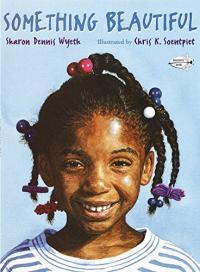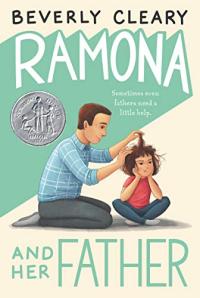
Even young monsters on Mars can have trouble adjusting to the first day of first grade. Not only does Horus miss the comforts of Martiangarten, but a know-it-all student harasses him. At his mother’s insistence, a very reluctant Horus returns the next day. Once there, he is able to forget his own problems when he helps a new and even more timid Martian. Characters are vividly colored and peculiarly shaped to create a comical but sympathetic school story of adjustment and emerging friendship.
First Graders from Mars: Horus’ Horrible Day

Harry knows that a terrible two-headed monster lives in his basement. So when his mother doesn’t return from a trip downstairs, Harry swallows his trepidations and goes down to rescue her. But when he confronts the monster face-to-face, it literally diminishes in size and eventually leaves Harry’s house forever. Humorous illustrations use black line and limited color to depict Harry overcoming a once fierce (but softly edged) monster.
Harry and the Terrible Whatzit

Every Sunday Tommy and his family visit the two nanas: upstairs Nana is Tommy’s great-grandmother who stays in bed because of her age; the active Nana downstairs is his grandmother. Tommy is forlorn when Nana upstairs dies, but comes to understand that she remains with him through his fond memories of times shared. New artwork in a larger format was created to celebrate the twenty-fifth anniversary of this modern classic.
Nana Upstairs & Nana Downstairs

A young girl learns to find beauty in her sometimes gritty urban neighborhood, showing how the way one sees makes a difference that affects others. Luminous watercolors detail the child, her neighborhood, and suggest what she sees around her.
Something Beautiful

Set in the 1950s, this book by Mildred Taylor is frank in its portrayal of racism. Lois and Wilma are proud when their father buys a brand new gold Cadillac. Only their mother won’t ride in it. On a trip from their home in Ohio to Mississippi, there are no admiring glances only suspicion directed toward the black man driving such a fancy car. For the first time, Lois knows what it’s like to feel scared because of her skin color.
The Gold Cadillac

Bluebonnets are the state flower of Texas. How they came to be is an Indian legend from the Comanche tradition. An orphan, She-Who-Is-Alone, is raised by the tribe in a time of drought and famine. Her sacrifice brings the people back into harmony with nature and saves the tribe. Stylized illustrations (though obviously still dePaola’s work) provide atmosphere for this inspiring, touching, and respectful tale.
The Legend of the Bluebonnet

A boy and his dog, each with his own thoughts, begin to deliver newspapers before the sun rises. Deeply hued, evocative illustrations document their journey through the quiet morning. As the sun comes up, boy and dog return to bed, satisfied that the job was well done.
The Paperboy

Eleven-year-old Angel and her seven-year-old brother are taken to live with their great-grandmother on her dilapidated Vermont farm. While the old woman is ill equipped to handle children, she’s better prepared to commit to them than either of their parents. A “star man” and the town librarian end up helping the children in this poignant exploration of family.
The Same Stuff as Stars

Six-year-old Ruby Bridges became the first African American to integrate an elementary school. Her memories of that year, when so much hatred was directed at her, makes for a powerful memoir. A 1999 Parents’ Choice Gold Award Winner.
Through My Eyes

For their family’s Christmas celebration, María’s mother makes lots of tamales. But while María is helping out, she tries on her mother’s ring and loses it in the dough. Without telling the adults, María and her young relatives try to find it — by eating all the tamales!
Too Many Tamales

Life isn’t easy for sisters Amber and Essie. Their mother works long hours; their father’s in prison; there’s generally little to eat. But there is joy in their creative play, neighbor friendships, and mutual love and support, which shines through difficulties. In poems and pictures that are never overtly sentimental, Williams eloquently and intimately reveals the sisters’ distinct personalities and their story.
Amber Was Brave, Essie Was Smart

Alfie, a preschooler, understands his baby sister, Annie Rose. Like most siblings, Annie Rose is both a delight and a trial. In this book, realistic illustrations depict real children in sometimes untidy but always recognizable settings.
Annie Rose Is My Little Sister

A boy and his father, shown as African Americans in warmly hued illustrations, enjoy doing everyday activities together, from laundry to sharing a book and more. The simple pleasures of family life are conveyed affectionately through easy but flowing language and realistic paintings in a sturdy format.
My Daddy and I

Kingsville, on the border of Mexico and Texas, comes to life in words and pictures in this book. Readers will share the simple joys of eating, dancing, and celebrating as the artist remembers her own childhood. Her stories, presented in both English and Spanish, are accompanied by her bright paintings.
In My Family / En mi familia

Harley is loner who just can’t seem to getalong with the other llamas. But a shepherd who needs to protect his flock from coyotes sees something else inHarley. Harley not only befriends the sheep, he becomes a loveable animal hero in this short but informative and captivating book.
Harley

Lilly is sick and tired of hearing about the wonders of Julius, her new baby brother. Because she wants him to go back to where he came from, Lilly spends a lot of time in the “uncooperative chair.” But when a cousin criticizes Julius, Lilly learns just how protective a big sister can feel. Deceptively simple line and wash illustrations show the intense emotions of Lilly and her mouse family.
Julius, Baby of the World

Jubilant illustrations show how a father supports his son as he grows into a man and eventually becomes a father himself. The text is from Will Smith’s popular song of the same name, and is distinguished by luminous, full-color paintings that make the words sing.
Just the Two of Us

At school Jack just doesn’t understand poetry or why he has to learn to write it. In free verse, as the words start out simple yet clear, we hear this reluctance to look for deeper meaning and his lack of confidence in writing anything that will be seen by others. But slowly, as he reaches deeper, Jack finds his voice – full of warmth, love, sadness, and loss.
Love That Dog

The son of superhero parents, Max is frustrated when even his cape and encouragement from his parents aren’t enough to help him learn to fly. But everything changes on the day he saves ababy bird and discovers that he, too, is a hero. Gently lined and colored illustrations depict slightlyfrumpy, appealing, characters in this engaging andencouraging tale.
Max

No matter how hard Ruby tries to get her baby brother to say the names of the objects around him, Max will only say “Bang!” One day, however, Ruby gets a big surprise from Max’s first real word. Understated humor and bright, bold illustrations appeal to children and their adults.
Max’s First Word

Seven-year old Ramona tries to take charge when her dad loses his job and her mother goes back to work out of the house full-time. Readers will see themselves in the Quimby household and are sure to chuckle at Ramona’s antics.
Ramona and Her Father

Clara is born into slavery but learns an important skill when she becomes a seamstress. Her quilting ability allows Clara to put together directions to escape north to freedom when she overhears a conversation about a route to Canada.
Sweet Clara and the Freedom Quilt

How does an older sibling respond to and feel about the inevitable changes when a baby joins a family? Straightforward text and crisp, full-color photographs present many aspects of a new baby – including diapers and other not-so-often discussed issues – while reassuring the older sibling of their continued place in a loving family.
The New Baby at Your House

Princess Elizabeth saves the kingdom (and the prince) from a fire-breathing dragon – and is told by the ungrateful Prince Roland that she looks a mess. The princess shows her stuff as she strikes out on her own, leaving the prince in the dust. A light touch and plenty of humor make this parody successful and its message clear.
